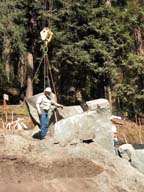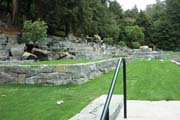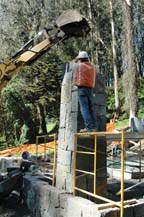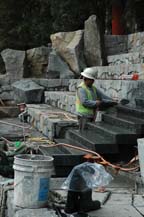

The existing property had been comprised of a grass lawn and an eroding hillside, explained Ed Westbrook, founder of QuarryHouse. “The park was smaller,†he said. “There were more trees, and it was not as open as it is now. [Also], there was an old theater stage that was dilapidated. The theater was really substandard - especially for the amount of people that would come.â€
In addition to the new amphitheater, the $15 million renovation project features new staging and visitor amenities. “The number one goal was to build a new facility to serve the people,†said Westbrook. “Secondly, it had to be made handicap accessible. There was quite a bit of infrastructure work that needed to be done such as drainage, grading, and putting roads in and out to accommodate the performers' equipment and bands, and the concert goers.â€

Searching for granite
Westbrook explained that he visited a few countries in search of the right building stone for the amphitheater, before selecting Chinese granite quarried by Chen-Ragen in the Shadong Province of China. “I looked in a couple of different countries,†he said. “I looked at American, Canadian and Mexican granite. Ultimately, we thought the Chinese granite could really do the job. When I saw this quarry, I said, 'That's got to be it.' The architect wanted gray, but didn't want a 'dead' gray. This had some brown.â€The supplier has a U.S. office based in Seattle, WA, and is headquartered in the Changsha Huan Province of China, according to Westbrook. “We have been working with them for over a decade,†he said. “We've done a lot of large-scale projects with them.â€
The standard stone pieces for the project ranged in size from 8 to 12 inches thick and weighed anywhere from 60 to 450 pounds, with the wall pieces being the largest. Additionally, some of the boulders weighed as much as 10 tons, according to Westbrook. “Basically, we decided to build this project in mass,†he said. “It can withstand earthquakes, sediment moving, etc. It's designed to last forever.â€
In total, Westbrook took six trips to China for this project, including an initial exploration visit about 18 months before construction began. “Part of the complexity was that the architect had a very specific vision for boulders,†said the stonemason, explaining that Halprin had made drawings of his vision. “In China, we made a pictograph, and went searching for boulders to fit each picture.â€
According to Westbrook, the boulders were taken from a huge waste pile at the quarry. “There were acres and acres of boulders,†he said. “We got as close as we could in size and shape. It was very artistic work.†Additionally, a mock-up was done at the quarry site to decide on the percentage of colors in the granite to use. “Everything was blended together,†said Westbrook.

Building the amphitheater
It took about six and a half months to complete the stonework at Stern Grove. “We had to work alongside every other trade,†said Westbrook. “That was a big logistic issue. We put one of our top senior people on the job. A lot of time was spent planning precise scheduling. [Also], it was one of the wettest winters.â€At peak production, there were about 45 workers on the jobsite, according to the stonemason. “The number went up and down a little bit, but we had a fairly large crew throughout,†he said. “This job required it.â€
To move the large stone pieces into place, small excavators and mini cranes were used on site. “We used some fairly innovated equipment,†said Westbrook.
Opening Day for the revitalized Stern Grove was held on June 19, 2005, with a ribbon-cutting ceremony led by San Francisco Mayor Gavin Newsom and Douglas E. Goldman, chairman of the Stern Grove Festival. The process of building the new stone amphitheater began in September of 2004, and there was an additional two years of pre-construction work, according to Westbrook.
